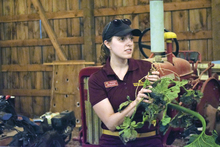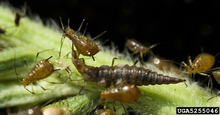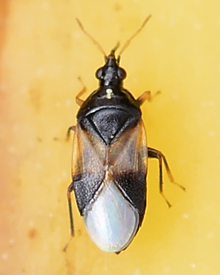Marissa Schuh brings an appreciation for insects to her University of Minnesota Extension work with gardeners and farmers
When Marissa Schuh appeared in the news last year on the topic of not-so-terrible things about wasps, she became known as “the wasp apologist.” And she was okay with that. “There are at least two sides to every story, and while a certain type of wasp can ruin one person’s day, there are many types and they all have a role to play.”
Seeing the big picture is really what integrated pest management (IPM) is all about.
Schuh, University of Minnesota Extension IPM educator, tells people about all the cool things that insects do for our gardens or farms, as well as what to do when they’re being a pain in the neck.
Many beneficial insects look familiar, but the education on them hasn’t caught up like it has on bees. “I love pollinators, but it’s time some of these other bugs get their shine on,” says Schuh. “Some bugs walk on water. Some bugs are like the aliens in the movie Predator and eat the ones that aren’t doing you any favors from the inside out. Once you start learning about them, it can be kind of hard to stop.”
Schuh has put together some information on beneficial insects on the Extension website.
Here are just a few to look for:
Lacewings
Lacewings have four life stages, but the immature stage is most beneficial, as they eat other insects.
- Minnesota is home to both brown and green lacewings.
- Eggs are small, but sometimes noticed because they are laid on the end of a hair-like stalk. Pupa appear as silk-coated spheres.
- Larvae have large, protruding jaws, and are capable of eating hundreds of aphids in their lifetime.
- Adult lacewings have slender bodies with long net-like wings, long slender antennae and golden eyes. They are about ¾ inches long.
- Adults are often seen near lights on summer nights.
- They have large mouthparts that are easily noticed, and you may see them feeding on other insects.
Promoting lacewings in gardens and farms
- Have consistently flowering plants in your space.
- Allow some aphids on plants.
- Limit pesticide applications.
- Leave some plant debris and leaves on the ground over the winter for habitat.
- While lacewing eggs are available for purchase, it’s important to keep their population in balance. They will eat other beneficial insects and pests.
Minute pirate bugs
Minute pirate bugs are often found around flowers, or on plants with an infestation of small insect pests. They do bite, and bites may be irritating but have no long-term effects.
- Minute pirate bugs have three life stages, all of which are small (less than 1 /5 inches long).
- Oval-shaped, black or black and white adults lay eggs that hatch and become adults over the course of three weeks.
- Immature minute pirate bugs are small, yellow, and they lack wings.
- Minute pirate bugs have a straw-like mouth part that they use to spear mites, thrips, aphids and more.
- They are available for purchase, but it’s not effective or practical to release them outside.
- Insect repellents have little effect on them. Work on cool, cloudy days when they’re less active to avoid bites.
Promoting minute pirate bugs in gardens and farms
- Have consistently flowering plants in your garden. They feed on small insects and will feed on pollen or nectar if no prey are available.
- Allow some amount of aphids to remain on plants.
- Limit pesticide applications. Many insecticides are not selective and will kill them.
Parasitoid wasps
Probably our most beneficial group of predatory insects, parasitoid wasps often go unnoticed.
- Parasitoid wasps need to lay their eggs inside other insects to complete their lifecycle.
- They are useful in controlling both native pests and invasive species.
- They do not sting or bite people, are solitary and do not have hives.
- Most are tiny, with many species being smaller than a millimeter, so they can only be positively identified by an expert.
- You may see adults feeding on or near flowers, or flying near plants as they look for a place to lay their eggs.
- Adults primarily feed on the pollen and nectar of flowers.
Promoting parasitoid wasps in gardens and farms
- Have consistently flowering plants in your outdoor spaces.
- Allow at least a low level of pest presence on plants.
- Limit pesticide applications.
- Professionals sometimes release parasitoids to control destructive insects, but for home gardeners it is usually better to make your space more welcoming to them, which will also attract other beneficial insects and native bees.





